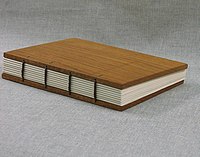Section (bookbinding)


In bookbinding, a section, gathering, or signature refers to a group of sheets, folded in the middle, and bound into the binding together.
The section is the basic building block of codex bindings. In Western bookbinding, sections are sewn through their folds, with the sewing thread linking each section to its neighboring sections.
The gatherings can be seen by looking at the top or bottom sides of the book, though cheaper modern books are perfect bound with no gatherings, gluing each sheet directly to the binding. The gatherings are sewn into the binding and the middle sheet of each gathering will have two or more short stretches of thread visible at the central fold.
In medieval manuscripts a gathering, or quire, was most often formed of 4 folded sheets of vellum or parchment, i.e. 8 leaves, 16 sides. The term "quaternion" (or sometimes quaternum) designates such a unit. A gathering made of a single folded sheet (i.e. 2 leaves, 4 sides) is a "bifolium" (plural "bifolia"); a "binion" is a quire of two sheets (i.e. 4 leaves, 8 sides); and a "quinion" is five sheets (10 leaves, 20 sides). This last meaning is preserved in the modern Italian meaning of quire, quinterno di carta. Later, when bookmaking switched to using paper and it became possible to easily stitch 5 to 7 sheets at a time, the number of sheets and pages in a gathering became more variable.
